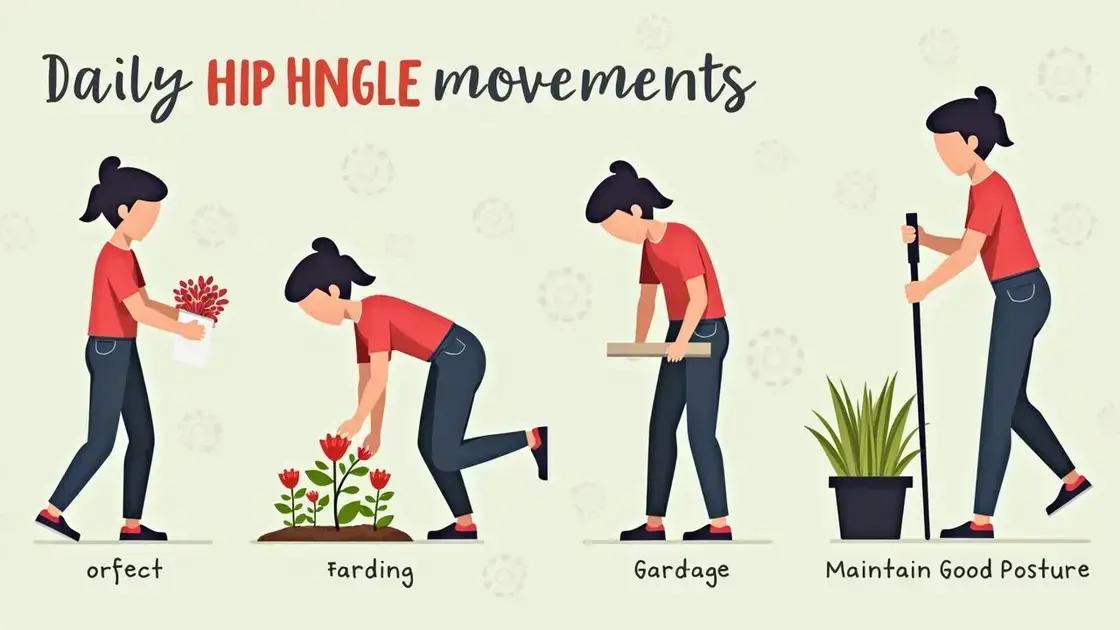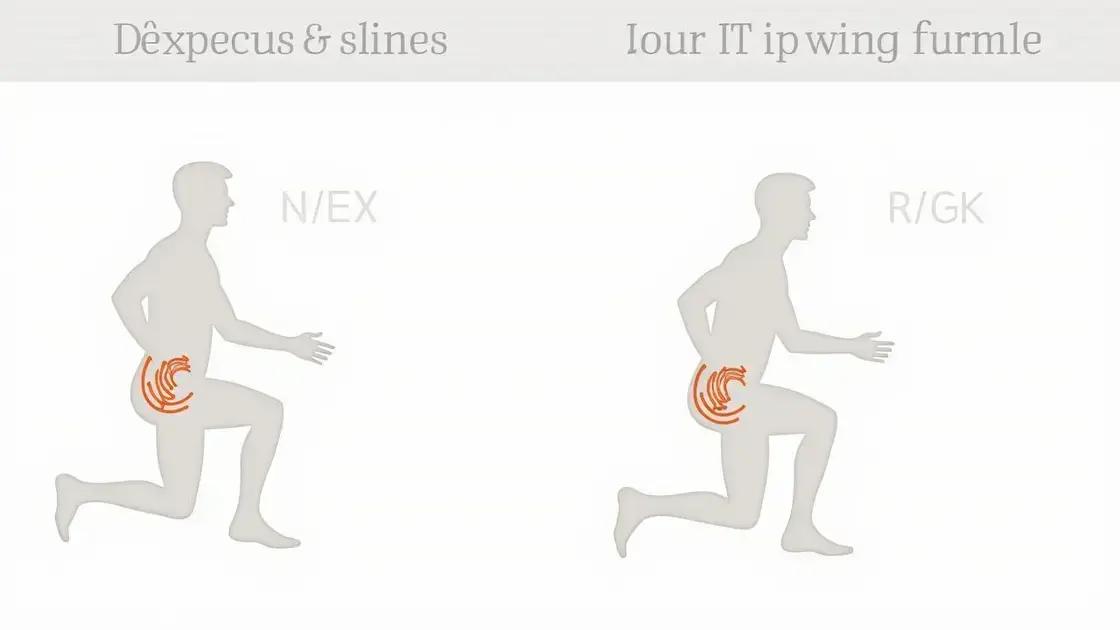The importance of hip hinge movements in daily life lies in their ability to improve posture, enhance strength, prevent injuries, and make everyday activities easier. Proper execution of hip hinges can significantly benefit overall mobility and functional performance.
Hip hinge movements are essential for maintaining proper posture and preventing injuries during daily tasks. Understanding the importance of these movements can significantly improve your health and mobility. In this article, we will delve into what hip hinge movements are, their benefits in everyday activities, and how to incorporate them into your daily routine effectively. Moreover, we’ll help you identify common mistakes to avoid, ensuring you maximize the advantages of hip hinging.
Understanding Hip Hinge Movements

Hip hinge movements are fundamental to how we move in our daily lives. This technique helps us bend forward while maintaining a flat back and engaged core, which is vital for performing many everyday tasks. Understanding how to perform a proper hip hinge can greatly reduce the risk of back injuries and improve overall body mechanics.
What is a Hip Hinge?
A hip hinge is a movement pattern where you bend at the hips while keeping your back straight. This movement is important when lifting objects from the ground or getting into a squatting position. Unlike squatting, where you bend your knees more, the hip hinge focuses on moving from the hips themselves.
Key Components of the Hip Hinge
To effectively execute a hip hinge, you should focus on the following components:
- Neutral Spine: Maintaining a straight back while hinging is crucial. This helps protect your spine and engage your core effectively.
- Hip Movement: The movement should come from the hips, leading the upper body forward as if pushing your butt out. However, ensure your knees do not extend excessively forward.
- Core Activation: Engaging your core during the movement helps stabilize your body and supports your spine.
- Weight Distribution: Keep your weight in your heels. This encourages proper posture and prevents strain on your knees.
Why Understanding the Hip Hinge is Important
Learning the hip hinge is crucial not just for athletes or fitness enthusiasts but for everyone. Most daily activities like picking up groceries, tying your shoes, or even getting out of a chair involve some form of hip hinge. By mastering this technique, you can enhance your physical performance and reduce the likelihood of injuries.
Additionally, understanding hip hinge movements can significantly benefit your workouts. Exercises like deadlifts and kettlebell swings rely heavily on this technique, making it essential for maximizing your fitness results.
Benefits of Hip Hinge in Daily Activities

The benefits of hip hinge movements extend far beyond the gym. Incorporating hip hinge techniques into daily activities can improve your overall quality of life. Here are some significant advantages:
Improved Posture
Practicing hip hinge movements regularly helps reinforce proper posture. This is essential for preventing slouching, which can lead to pain in the neck and lower back. With correct posture, you will appear taller and more confident.
Injury Prevention
Many injuries occur due to improper lifting techniques. By mastering the hip hinge, you can protect your back when lifting heavy objects, like grocery bags or boxes. This movement teaches you to use your legs and hips rather than straining your back.
Enhanced Strength
The hip hinge is foundational for many strength-training exercises, such as deadlifts and kettlebell swings. By using these movements in daily life, you build functional strength that translates into better performance during workouts.
Better Mobility
Incorporating hip hinge movements can enhance your hip flexibility and overall mobility. As you practice this technique, you will find it easier to bend down, pick things up, or engage in activities like gardening or playing with your children.
Efficient Energy Use
Using the hip hinge allows you to conserve energy during movements. Instead of relying solely on your back, you’re engaging larger muscle groups. This efficiency leads to less fatigue, allowing you to engage more actively in various activities throughout your day.
How to Incorporate Hip Hinge into Your Routine

Incorporating hip hinge movements into your daily routine can greatly enhance your overall functionality and well-being. Here are some practical ways to make hip hinging a regular part of your life:
Start with Awareness
Pay attention to how you move throughout the day. Take note of activities that might benefit from hip hinge techniques. Simple actions like picking up items from the floor or bending down should remind you to hinge at the hips rather than bending at the waist.
Practice Exercises
Engage in specific exercises that promote proper hip hinge mechanics. Deadlifts and kettlebell swings are great starting points. Practice these with lighter weights to focus on form before progressing to heavier loads.
Daily Activities
Apply hip hinge techniques in daily routines. When you pick something up, consciously push your hips back and keep your spine straight. Use this technique when loading groceries into your car or picking up children.
Set Reminders
Set reminders on your phone or put sticky notes around your home to remind you to practice the hip hinge. Repeating the movement helps reinforce it until it becomes second nature.
Join a Class or Workshop
Consider joining a fitness class or workshop that focuses on functional movements. These classes often include instruction on the hip hinge and provide an opportunity for hands-on learning.
Stay Consistent
Like any new habit, consistency is key. Try to incorporate hip hinge movements into your routine every day. Regular practice will help you master this beneficial movement technique, leading to improved posture and reduced risk of injury.
Common Mistakes with Hip Hinge Movements

Understanding common mistakes with hip hinge movements is essential for maximizing benefits and avoiding injuries. Here are some frequent errors people make:
Not Maintaining a Neutral Spine
A common mistake is losing the neutral spine position during hip hinges. Many people tend to round their back instead of keeping it straight. This can lead to back injuries and chronic pain. Always focus on maintaining a straight back throughout the movement.
Forgetting to Engage the Core
Failing to engage the core is another mistake. A strong core provides stability and support for your spine during hip hinge movements. Make sure to tighten your abdominal muscles before you start the hinge to protect your back.
Bending the Knees Too Much
Some individuals bend their knees excessively, turning the hip hinge into more of a squat. While knee bending is natural to an extent, the hinge should primarily come from the hips. Make sure your knees remain slightly bent but don’t extend too far forward.
Incorrect Weight Distribution
Many people make the mistake of leaning too far forward without adequate weight distribution. Ensure that your weight is centered in your heels, not your toes. This helps maintain balance and proper alignment while performing the hinge.
Neglecting to Practice
Finally, some individuals do not practice the hip hinge enough to master it. Like any skill, the hip hinge requires repetition and awareness. Dedicate time to practicing both in the gym and during everyday activities to develop proper mechanics.
In conclusion, embrace the hip hinge for a better life
Understanding and incorporating hip hinge movements into your daily routine offers tremendous benefits, from improving posture to preventing injuries. By practicing the correct technique and avoiding common mistakes, you will enhance your mobility and strength.
As you become more aware of how to properly execute hip hinges in various activities, you’ll find it easier to integrate this essential movement into your lifestyle. Remember, consistency is the key to mastery.
Ultimately, making the hip hinge an integral part of your daily movements will not only support your physical health but also promote a more active and fulfilling life.
FAQ – Frequently Asked Questions about Hip Hinge Movements
What is a hip hinge movement?
A hip hinge movement is a bending motion that originates from the hips while maintaining a straight back. It is essential for proper lifting and mobility.
Why are hip hinge movements important in daily life?
Hip hinge movements help improve posture, reduce the risk of injury, and enhance strength and mobility, making everyday tasks easier and safer.
How can I practice hip hinge movements effectively?
You can practice hip hinge movements by engaging in exercises like deadlifts and kettlebell swings, as well as being mindful of your posture while lifting objects.
What are common mistakes to avoid when performing hip hinges?
Common mistakes include rounding the back, excessive knee bending, poor weight distribution, and neglecting to engage the core.
How can I incorporate hip hinge movements into my routine?
Incorporate hip hinge movements by practicing them during daily activities, setting reminders, and performing specific exercises that emphasize this movement technique.
Can hip hinge movements prevent injuries?
Yes, mastering hip hinge techniques can prevent injuries by promoting proper lifting mechanics and reducing strain on the back during daily tasks.












